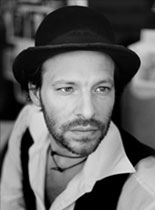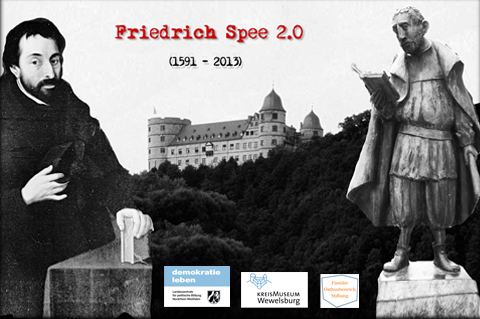
News
Roman Kroke
Interdisciplinary Artist
16.-18. October 2013
Witch Hunts in the Mirror of History: Workshop Première “Friedrich Spee 2.0″, Wewelsburg Castle (Germany)
Roman Kroke developed a pedagogic-artistic concept and led a workshop on the Jesuit Friedrich Spee (1591-1635), a fervent critic of medieval witch trials. Location: the former “Obergruppenführer “ Hall of the Third Reich “Schutzstaffel” (SS) at the Wewelsburg Castle (Germany) – initiator and organizer of the project: Dr. Angelika Gausmann – in cooperation with the Wewelsburg District and Memorial Museum – funded by the Centre for Political Education of North-Rhine-Westphalia, the Förderverein Kreismuseum Wewelsburg e.V. and the Familie-Osthushenrich-Foundation.
“Whether witches, hags, and sorcerers really exist?”
“Who in particular are the people who continually incite the rulers against witches?”
Questions which Friedrich Spee examined in the Cautio Criminalis, his fiery pamphlet against witch trials, about 400 years ago.
On the occasion of the 20th anniversary of the Friedrich-von-Spee-Gesamtschule (Paderborn/Germany) students faced the challenge to build through their artworks a bridge between the historic figure Friedrich Spee of the 16th century to an imaginative Friedrich Spee of the 21st century. Who are the “witches” of our time, how are they – metaphorically speaking – “burned” (see also so-called “flaming“) and what motives for their persecution may be identified? How would Spee for instance meet the modern phenomena of cyberbullying and electronic harassment?
For the very first time the Wewelsburg District Museum opened the historical North Tower of the castle to become the scenery of an art project. The former “Obergruppenführer” Hall of the Third Reich Schutzstaffel (SS) situated at the ground floor of the tower had been deliberately chosen as our studio: According to the final visions of “Reichsführer SS” Heinrich Himmler, the Wewelsburg castle was to become the cult site of the SS after the “Endsieg” (final victory) – with the North Tower constituting its central point, architecturally enriched with Nordic characters, occult ornaments and decorations. For this, the SS had parts of the castle reconstructed by prisoners from the nearby Niederhagen concentration camp. At least 1,285 of the over 3,900 prisoners died as a result of the work and prison conditions, at least 56 were executed by the SS. One of the most striking remnants of the Nazi architecture, an enormous floor mosaic, is placed in the very epicenter of the North Tower: the twelve spoked sun wheel, which is a popular character of recognition for right wings and Neo-Nazis today.
The goal of the project was to transform this historically charged hall into a place where artistic creation stimulates practical reflection about human rights, discrimination, tolerance as well as commemoration of murdered and persecuted people. The project also included a visit of the preserved dungeons of the Wewelsburg castle, where witches were tortured in the Middle Ages; further inspiration for their artworks the students gathered during a lecture of the Spee researcher Mrs. Sarah Masiak and members of an NGO assisting prisoners of the nearby detention centre in Büren.
The artworks created by the students during the three-day workshop are currently displayed in a temporary exhibition in the North Tower of the Wewelsburg castle.
Special thanks to: Dr. Angelika Gausmann (initiator and organizer of the project) ; Mrs. Kirsten John-Stucke (Head of the Wewelsburg District Museum), Mrs. Katharina Dehlinger (Educational Department of the Museum); Mr. Lothar Schlegel (Head of the Friedrich-von-Spee-Gesamtschule Paderborn), Mrs. Sarah Masiak (researcher), Mr. Rodi Yousef (trainee teacher), the association “Hilfe für Menschen in Abschiebehaft Büren” – for the funding of the project: the Centre for Political Education of North-Rhine-Westphalia, the Förderverein Kreismuseum Wewelsburg e.V. and the Familie-Osthushenrich-Foundation.
Recommended L I N K S :
Cautio Criminalis (extract from the English publication)
About the history of the Wewelsburg Castle (article by Mrs. Kirsten John-Stucke)
 Facebook
Facebook Google+
Google+ WordPress
WordPress
